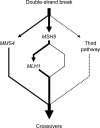Competing crossover pathways act during meiosis in Saccharomyces cerevisiae
- PMID: 15611158
- PMCID: PMC1448724
- DOI: 10.1534/genetics.104.032912
Competing crossover pathways act during meiosis in Saccharomyces cerevisiae
Abstract
In Saccharomyces cerevisiae the MSH4-MSH5, MLH1-MLH3, and MUS81-MMS4 complexes act to promote crossing over during meiosis. MSH4-MSH5, but not MUS81-MMS4, promotes crossovers that display interference. A role for MLH1-MLH3 in crossover control is less clear partly because mlh1Delta mutants retain crossover interference yet display a decrease in crossing over that is only slightly less severe than that seen in msh4Delta and msh5Delta mutants. We analyzed the effects of msh5Delta, mlh1Delta, and mms4Delta single, double, and triple mutants on meiotic crossing over at four consecutive genetic intervals on chromosome XV using newly developed computer software. mlh1Delta mms4Delta double mutants displayed the largest decrease in crossing over (13- to 15-fold) of all mutant combinations, yet these strains displayed relatively high spore viability (42%). In contrast, msh5Delta mms4Delta and msh5Delta mms4Delta mlh1Delta mutants displayed smaller decreases in crossing over (4- to 6-fold); however, spore viability (18-19%) was lower in these strains than in mlh1Delta mms4Delta strains. These data suggest that meiotic crossing over can occur in yeast through three distinct crossover pathways. In one pathway, MUS81-MMS4 promotes interference-independent crossing over; in a second pathway, both MSH4-MSH5 and MLH1-MLH3 promote interference-dependent crossovers. A third pathway, which appears to be repressed by MSH4-MSH5, yields deleterious crossovers.
Figures




References
-
- Agarwal, S., and G. S. Roeder, 2000. Zip3 provides a link between recombination enzymes and synaptonemal complex proteins. Cell 102: 245–255. - PubMed
-
- Allers, T., and M. Lichten, 2001. a Differential timing and control of noncrossover and crossover recombination during meiosis. Cell 106: 47–57. - PubMed
-
- Allers, T., and M. Lichten, 2001. b Intermediates of yeast meiotic recombination contain heteroduplex DNA. Mol. Cell 8: 225–231. - PubMed
-
- Bishop, D. K., and D. Zickler, 2004. Early decision: meiotic crossover interference prior to stable strand exchange and synapsis. Cell 117: 9–15. - PubMed
Publication types
MeSH terms
Substances
Grants and funding
LinkOut - more resources
Full Text Sources
Molecular Biology Databases

